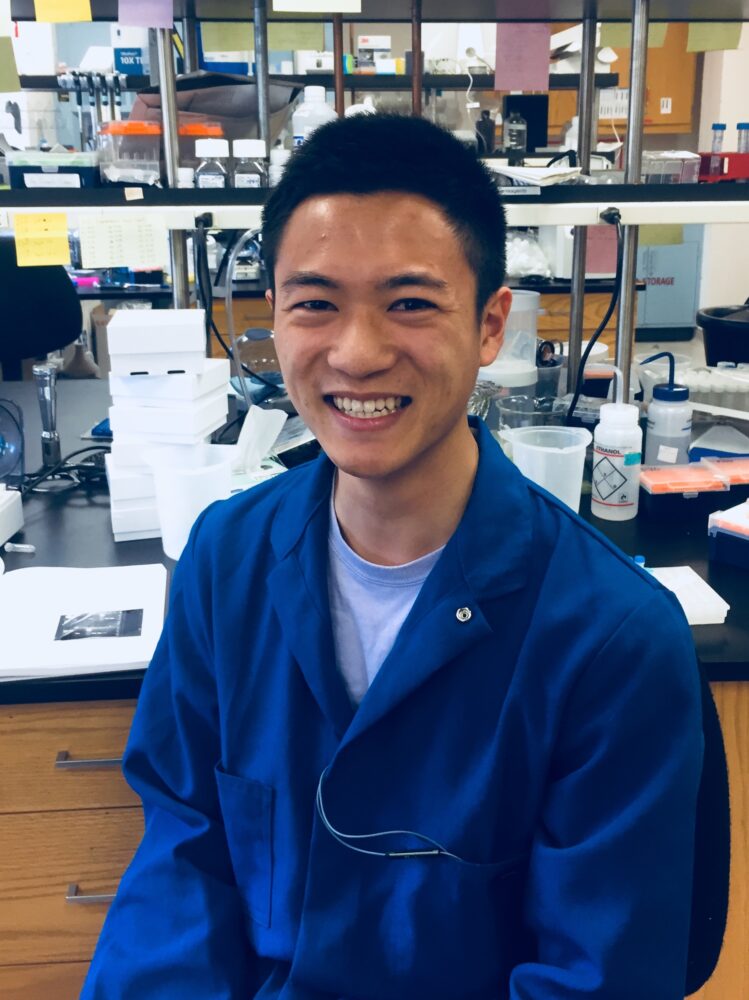Nicholas Carey

We are studying the eighth human herpes virus; Kaposis Sarcoma-Associated Herpesvirus (KSHV). This is a sexually transmitted virus that establishes life-long infections. KSHV does not cause symptoms in most people but is known to cause three types of cancer (Kaposis Sarcoma, Pulmonary Effusion Lymphoma, and Multicentric Castleman Disease) in immunocompromised people, such as those with HIV/AIDS. It is estimated that 20-50% of people with HIV are also infected with KSHV. KSHV has several regions of DNA called open reading frames (ORFs) that are completely unique and their role in the […]
Huws Landsberger

The gravitational behavior of antimatter has critical bearing upon our understanding of particle physics, quantum gravity, and the expansion of the universe. The weak equivalence principle (WEP) states any particles gravitational acceleration is the same, conflicting with quantum theory, which imposes limits on the certainty of position and momentum (thus trajectory) of particles. ALPHA-G, a new antimatter gravity experiment being performed at CERN, tests how gravity acts upon antihydrogen as a test of the WEP. Confining and cooling antihydrogen such that gravitational rather than thermal effects are measured requires strong […]
Alex Oanta

Metal-promoted reactions are frequently utilized in the syntheses of complex organic products that are vital to the pharmaceutical and petroleum industries. With the intention of discovering new, more efficient chemical pathways to otherwise inaccessible or costly organic chemicals, many inorganic chemists devote their careers to the synthesis and study of discrete molecular compounds centered on a well-defined metal ion. Previous reactivity studies on such molecular metal-based compounds support the conjecture that electronically saturating the valence orbitals of a metal with multiple ligands can enhance the reactivity of the electrons involved […]
Alyson Kishi

Precise and coordinated motor movement, such as prehension, is an essential skill for completing everyday tasks. The aim of this study is to quantify the relationship between stereopsis (the ability to see depth) and skilled prehension (the ability to precisely grasp an object). We present objects in a frontal view that minimizes other cues to their shape and ask participants to reach and pick up the objects while recording their hand movements. Because grasping an object relies on 3-dimensional object properties and relative disparity, we predict that individuals with anomalous […]
Percival Chen

Gregor Mendels law of equal segregation states that the two copies of each chromosome are transmitted with equal probability to the offspring. However, there are also genes, termed meiotic drivers, that manipulate the genome to be transmitted at greater than 50% frequency. Meiotic drivers have been identified across taxa (including insects, plants, fungi, and mammals), and have profound genomic, evolutionary, and ecological consequences. Moreover, the development of synthetic drive systems is the focus of multiple research groups as a means to control pest and disease vectors, since the >50% transmission […]
Andrew Hong
Prostate cancer (PCa) is the most common noncutaneous cancer in men and presents with a heterogeneous disease course ranging from indolent to rapidly progressive, fatal disease. Imaging techniques such as magnetic resonance (MRI) and positron emission tomography (PET) imaging are important for differentiating between these phenotypes and selecting appropriate patients for treatments. Although low zinc concentration in malignant prostate tissue has been identified as a biomarker for the presence of and aggressiveness of PCa, there is no method for imaging zinc biodistribution in routine clinical use. One solution is hyperpolarized […]
Dylan Stover

Plant communities respond to disturbances in many ways; with the increase in disturbance events in California such as fires and droughts, these community responses have increasingly led to unexpected shifts in dominant plant species that negatively affect their ecosystems through each species ecosystem services. In a drought and fire prone place such as Tejon Ranch in Californias central valley, it is vital for the lands managers to understand every plants response to disturbances. My project focuses on a native Californian shrub that, though common on the ranch, has not yet […]
Kayla Maanum

Direction-selective ganglion cells (DSGCs) are characterized from other retinal ganglion cells because they generate a higher rate of action potentials when a moving light stimulus passes over the cell in its preferred direction than when the stimulus moves in the opposite or null direction. Four subtypes of DSGCs have been elucidated, each of which prefer one of the four cardinal directions of visual motion: dorsal, ventral, temporal, and nasal. Although asymmetric synaptic circuitry is a common property of these DSGCs in the mouse retina, asymmetric dendritic morphology is not. However, […]
Angel Najera
The internet essentially functions like a mailing system, with data packets sent across a network of devices. These devices act like the post offices and shipping warehouses from our regular mailing system. Until recently, modifying the way things ran for each device worked in a similar fashion to training a new worker. In our case, it took years for manufacturers to develop new hardware that did what the network managers wanted. This is where P4 comes in; it is now feasible to change the functionality of forwarding devices by directly […]
Ravi Mandla

One of the fastest heart rates in the world belongs to one of the smallest mammals, the Etruscan Shrew. Only weighing around 1.8 grams, this animal has a heart rate of 1511 beats per minute (in comparison, human heart rates are around 80 beats per minute). In contrast, the blue whale has a heart rate of about 8 bpm. This phenomenon of heart rate scaling can consistently be found throughout the animal kingdom, with smaller organisms possessing a higher heart rate compared to that of larger animals, though little research […]